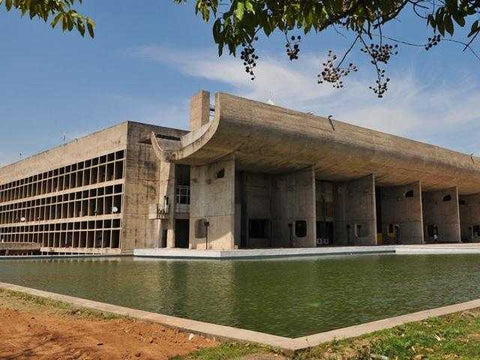Chandigarh Capitol Complex

Chandigarh Capitol Complex, located in the sector-1 of Chandigarh city in India, is a government compound designed by the architect Le Corbusier and is a UNESCO World Heritage Site.It is spread over an area of around 100 acres and is a prime manifestation of Chandigarh's architecture. It comprises three buildings, three monuments and a lake, including the Palace of Assembly or Legislative Assembly, Secretariat, High Court, Open Hand Monument, Geometric Hill and Tower of Shadows. It was added in UNESCO World Heritage Site List in 2016.
Chandigarh is the best-planned city in India, with architecture which is world-renowned, and a quality of life, which is unparalleled. As the capital of the states of Punjab and Haryana, and the Union Territory of Chandigarh it is a prestigious city. The face of modern India, Chandigarh, is the manifestation of a dream that Pt. Jawahar Lal Nehru envisaged and Le Corbusier executed.
Serenity and a city are two diametrically opposite concepts, which however, get belied in the 'City Beautiful'. Chandigarh is a rare epitome of modernization co-existing with nature's preservation. It is here that the trees and plants are as much a part of the construction plans as the buildings and the roads. India’s first planned city, is a rich, prosperous, spic and span, green city rightly called “ THE CITY BEAUTIFUL ”.
he new sites, in their order of inscription are:
The Architectural Work of Le Corbusier, an Outstanding Contribution to the Modern Movement (Argentina, Belgium, France, Germany, India, Japan, Switzerland)—Chosen from the work of Le Corbusier, the 17 sites comprising this transnational serial property are spread over seven countries and are a testimonial to the invention of a new architectural language that made a break with the past. They were built over a period of a half-century, in the course of what Le Corbusier described as “patient research”. The Complexe du Capitole in Chandigarh (India), the National Museum of Western Art, Tokyo (Japan), the House of Dr Curutchet in La Plata (Argentina) and the Unité d’habitation in Marseille (France) reflect the solutions that the Modern Movement sought to apply during the 20thcentury to the challenges of inventing new architectural techniques to respond to the needs of society. These masterpieces of creative genius also attest to the internationalization of architectural practice across the planet.
Serenity and a city are two diametrically opposite concepts, which however, get belied in the 'City Beautiful'. Chandigarh is a rare epitome of modernization co-existing with nature's preservation. It is here that the trees and plants are as much a part of the construction plans as the buildings and the roads. India’s first planned city, is a rich, prosperous, spic and span, green city rightly called “ THE CITY BEAUTIFUL ”.
he new sites, in their order of inscription are:
The Architectural Work of Le Corbusier, an Outstanding Contribution to the Modern Movement (Argentina, Belgium, France, Germany, India, Japan, Switzerland)—Chosen from the work of Le Corbusier, the 17 sites comprising this transnational serial property are spread over seven countries and are a testimonial to the invention of a new architectural language that made a break with the past. They were built over a period of a half-century, in the course of what Le Corbusier described as “patient research”. The Complexe du Capitole in Chandigarh (India), the National Museum of Western Art, Tokyo (Japan), the House of Dr Curutchet in La Plata (Argentina) and the Unité d’habitation in Marseille (France) reflect the solutions that the Modern Movement sought to apply during the 20thcentury to the challenges of inventing new architectural techniques to respond to the needs of society. These masterpieces of creative genius also attest to the internationalization of architectural practice across the planet.
The Shadow Tower, Capitol Complex. Le Corbusier constructed it in such a way that not a single ray of sun enters it from any angle (specifically in summer). The north side of this tower remains open because the sun never shines from this direction. Le Corbusier used the same principle for other Capitol Complex buildings as well.
At a glance
| Location | North India |
| Linking Roads | National Highway 21 and 22 |
| Significance | Capital of Two States |
| Postal Code | 160 017 GPO |
| ISD Code | 91 |
| STD Code | 0172 |
| Web Site | http://chandigarh.gov.in/ |
| Longitude | 760 47' 14 E |
| Latitude | 300 44' 14 N |
| Area | 114 square kms |
| Altitude | 304 - 365 meters above MSL |
| Annual Rainfall | 104.8 cm/yearly average (April 2004 to March 2005) |
| Monsoon | July - September |
| Climate |
Winter (Nov-Jan) Min 4°C-14°C
Summer (April-July) Max.37°C - 44°C
|
| Villages | 24 (As per 2011 census) |
| Population | 10,54,686 (As per 2011 census) |
| Urban Population | 10,25,682 (As per 2011 census) |
| Rural Population | 29,004 (As per 2011 census) |
| Literacy Rate | 86.43 % (As per 2011 census) |
| Languages |
Punjabi, Hindi, English
|
| Best Season to visit |
The best season to visit Chandigarh is autumn, i.e., from mid-August to November, when the weather is pleasant, neither too hot, nor too cold, prevalent Winds from the South East in Summer and from the Northwest in Winter.
|
| Air Quality |
Chandigarh's ambient air quality is better than that of most other cities in the world. In Chandigarh only non polluting and power driven industries are permitted.
|
No comments:
Post a Comment